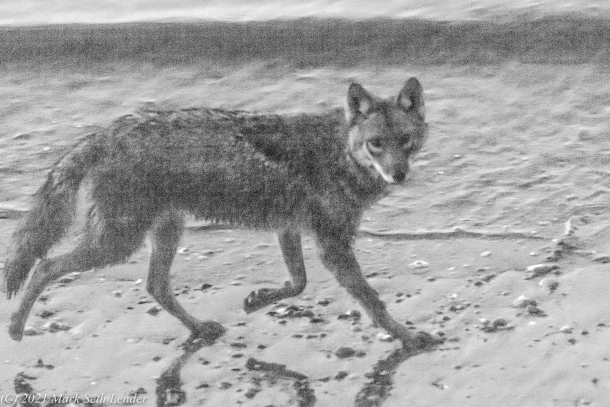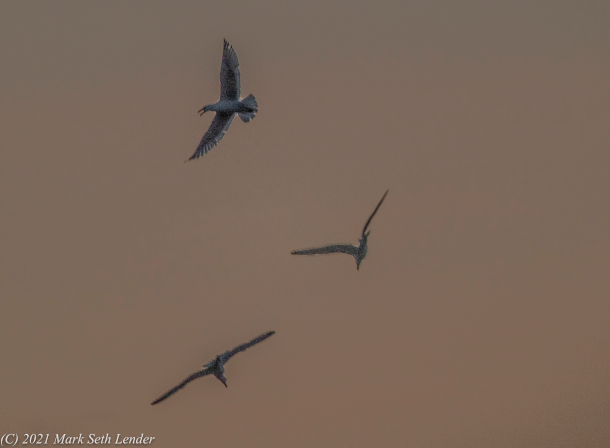Coyote On The Beach
Air Date: Week of July 2, 2021

To warn others of danger, herring seagulls use a series of volume modulation, syllables, and even visual gestures to communicate. In one such instance, a herring seagull spots a coyote on the beach and lets out a loud warning cry. (Photo: Mark Seth Lender)
Through a combination of gestures, pitch and volume, herring gulls are able to “speak.” With each variation of visual and linguistic components, these gulls are able to vocalize “phrases,” communicating alarm calls and signals. Take a listen as Living on Earth's Explorer-in-Residence Mark Seth Lender narrates a scene of herring seagulls taking a stand against a coyote.
Transcript
CURWOOD: It’s Living on Earth. I’m Steve Curwood
BASCOMB: And I’m Bobby Bascomb. We travel to Connecticut with Living on Earth’s Explorer in Residence, Mark Seth Lender.
LENDER: The herring gulls are circling. They wheel and wheel as they move down the shoreline calling, Look! Look here! Look out! That’s what their voices mean. Thin. Uncertain. A frisson that passes through the flock.
It is impossible to see what they see. The sun is never awake at this hour. The only light is a muddy reddish stain that pulls up behind them in the sky. What disturbs the herring gulls must be close enough to be a threat or at least, seem out of place. Like house cats they notice anything they are not used to. Even the crack in the seawall that opened after the storm which they did not like at all. They are low, maybe fifty feet, and almost overhead now -
and there it is.
Instead of Up I should have been looking down:
Coyote on the beach!
Young, thin, long-legged, he looks more wolf than Song-dog except for the lack of confidence. He glances over his shoulder at the gulls, and again, and then -
He sees me looking right at him.
Coyote loses his trajectory and strays across the tideline. Saltwater lifts in silver arcs from his paws, splashes down, it sounds like the clinking of glass. Other than this he is silent, does not open his mouth, not even to gasp for breath, and continues. Staring as he passes then loping almost at a run.

Herring seagulls have scavenging habits which take them to open ocean water and spaces, like the beach. They prey on marine invertebrates, fish, insects, and crabs and crayfish. Always on the lookout for anything out of the ordinary, they communicate signals and warning calls to each other. (Photo: Mark Seth Lender)
The gulls have given Coyote away. A Human has found him. The thing he feared.
At a large breakwater a hundred yards on he bucks up and at the top, stops and looks at me one last time. Then turns, down between the boulders, and again onto the sand and settles into his stride going west at a steady trot until in the grayness and the distance he is lost from sight...
The herring gulls disperse.
Everything is back to normal.
BASCOMB: That's Living on Earth’s Explorer in Residence Mark Seth Lender.
Links
Read the Field Note for this essay
Check out Smeagull's Guide to Wildlife
Read Mark Seth Lender’s book on seagulls: Smeagull the Seagull
Learn more about author and photographer Mark Seth Lender’s work
Special thanks to Stewart B. McKinney National Wildlife Refuge
Living on Earth wants to hear from you!
Living on Earth
62 Calef Highway, Suite 212
Lee, NH 03861
Telephone: 617-287-4121
E-mail: comments@loe.org
Newsletter [Click here]
Donate to Living on Earth!
Living on Earth is an independent media program and relies entirely on contributions from listeners and institutions supporting public service. Please donate now to preserve an independent environmental voice.
NewsletterLiving on Earth offers a weekly delivery of the show's rundown to your mailbox. Sign up for our newsletter today!
 Sailors For The Sea: Be the change you want to sea.
Sailors For The Sea: Be the change you want to sea.
 The Grantham Foundation for the Protection of the Environment: Committed to protecting and improving the health of the global environment.
The Grantham Foundation for the Protection of the Environment: Committed to protecting and improving the health of the global environment.
 Contribute to Living on Earth and receive, as our gift to you, an archival print of one of Mark Seth Lender's extraordinary wildlife photographs. Follow the link to see Mark's current collection of photographs.
Contribute to Living on Earth and receive, as our gift to you, an archival print of one of Mark Seth Lender's extraordinary wildlife photographs. Follow the link to see Mark's current collection of photographs.
 Buy a signed copy of Mark Seth Lender's book Smeagull the Seagull & support Living on Earth
Buy a signed copy of Mark Seth Lender's book Smeagull the Seagull & support Living on Earth

